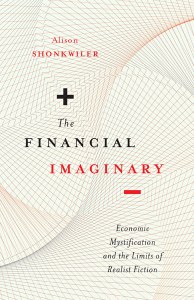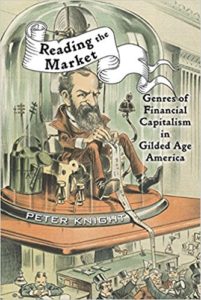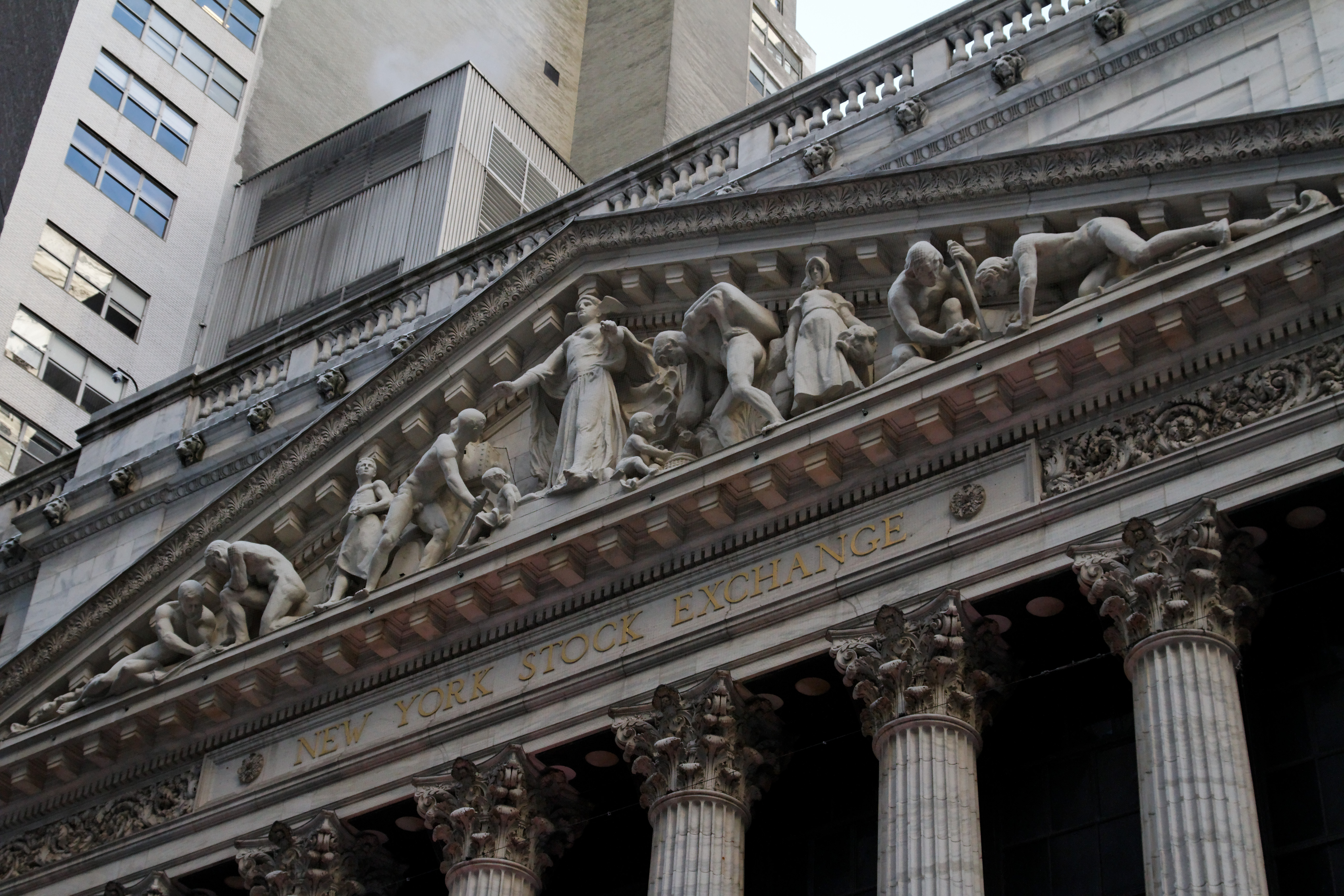
 Alison Shonkwiler, The Financial Imaginary: Economic Mystification & The Limits of Realist Fiction (University of Minnesota Press, 2017)
Alison Shonkwiler, The Financial Imaginary: Economic Mystification & The Limits of Realist Fiction (University of Minnesota Press, 2017)
Peter Knight, Reading the Market: Genres of Financial Capitalism in Gilded Age America (Johns Hopkins University Press, 2016)
Reviewed by Matt Seybold
Matthew Arnold spends much of Civilization in the United States (1888) savaging the nation’s literary tastes. Arnold derides “the glorification of ‘the average man,’” the “addiction to ‘the funny man,’ who is a national misfortune,” and, in case it isn’t abundantly clear who he’s talking about, “the Quinionian humour of Mr. Mark Twain, so attractive to the Philistine of the more gay and light type” (Arnold 1888: 92, 177). Twain read Arnold’s book shortly after it was published and felt “a friendly word was needed in our defense” (Clemens 1888: 5). This he offered in an open letter to the President of Yale University.
The conceit of the letter is that the honorary degree Yale had recently awarded him is “sufficient” to relieve Twain of the temptation to publicly rebuke Arnold. He speculates as to what kind of immodest and unbecoming things he “might” have said, but “since you have rehabilitated us it is not necessary” (5), he writes, just before copying this “private” correspondence to his local Hartford Courant. From there the letter circulated virally through the newspapers Arnold had recently recriminated, as Twain knew it would, further feeding the native “addiction” to his sarcastic wit.
It is a master class in the art of trolling.
But the Yale letter also contains a sincere apologia for the brand of literature appearing in the U.S. periodicals Arnold denounced, like Atlantic Monthly. Twain’s letter was ingeniously designed to “remind the world that ours is a useful trade, a worthy calling” with “one serious purpose, one aim, one specialty, and it is constant to it – the deriding of shams, the exposure of pretentious falsities, the laughing of stupid superstitions out of existence…whoso is by instinct engaged in this sort of warfare is the natural enemy of royalties, nobilities, privileges, and all kindred swindles, and the natural friend of human rights and human liberties” (5).
In the final two decades of his career, as his celebrity continued to grow, Twain pursued this singular purpose more aggressively, focusing especially on the shams and pretentions of colonialism and cultural imperialism. It was as if Matthew Arnold’s face was pasted to his dartboard. Many of his fellow novelists, some of whom he expressly trained in “this sort of warfare,” took their fight to a “kindred swindle,” and even won a few skirmishes against the likes of J. P. Morgan and J. D. Rockefeller. The concurrence of muckraking realism and progressive political economy at the turn of the twentieth century is a notable example of how “the novel has,” as Alison Shonkwiler puts it, “at various times in its history, aimed to destabilize capitalist reality” (Shonkwiler 2017: xxx).
Both Shonkwiller, in The Financial Imaginary (2017), and Peter Knight, in Reading the Market (2016), present U.S. literature engaged in a “sort of warfare” with financialization. It is not, as one might expect, a conflict driven by difference. Rather, it is a dispute over shared territory, a border war mobilized by concordances in how financiers and novelists “think,” as Shonkwiler frames it; that is, how they deal with the representational limitations imposed upon them by their prescribed mediums, their imagined audiences, and their own subjectivities. Knight shows how genres of financial capitalism, from the ticker tape itself to conspiracy theories aimed at influencing investment patterns, depend upon readers whose literacy is developed through popular forms. Financial media must, therefore, borrow liberally from familiar narratives, both fictional and factual, until the reading habits of the nation are no longer “merely a passive reflection of an existing economic reality but part of the cultural armature that helps create it” (Knight 2016: 15).
Crucial to both accounts is the inherent “fictiveness,” “fictionality,” and “fictitiousness” of finance. The imaginative and speculative pretexts to literary and financial forms create grounds for analogies between them. Both scholars explore these parallels, but are most interested in whether (and how) the mutual territory of the literary and financial imaginary endows literature, particularly realist literature, with the capacity to reveal and resist the totalizing forces of financialization. Because of the overlap between these crafts, Shonkwiler argues, critical readers of novels may be better prepared to interrogate financial forms. Knight shows that nineteenth-century fiction writers sought to create competing representations of the financial economy to expose and unsettle the “cultural armature” upon which it rests.
For Shonkwiler, it is a kamikaze “sort of warfare.” Novelists have increasingly been willing to highlight the counterfactuality and constructedness of their own works, and by doing so reveal the counterfactuality and constructedness of other mediums, like financial products, which prefer to evade such transparency. For Twain and Henry James, the demystification of British cultural imperialism was achieved in part by ridiculing the romantic precedents to their own preferred genre: the novel. In many of the “economic novels” of 1890s and 1900s, realists would exchange the romantic hero as object of demystification for what Shonkwiler calls “economic virtue,” the strained effort to “maintain the integrity of the self in the face of gambling temptations” (2). Knight traces the manufacture of such virtue through corporate publicists’ and neoclassical economists’ efforts to glorify greed with shallow appropriations of Adam Smith, efforts pilloried in Upton Sinclair’s The Moneychangers (1908) and Frank Norris’s The Octopus (1901).
According to Shonkwiler, that generation of economic novels “marks the historical end of one kind of capitalist realism, where market value is grounded in character, and the beginning of another kind of capitalist realism, where character and history are both grounded in the market” (29). Most of her book focuses on this second kind. Post-45 novels may not be conventionally associated with realism, but possess “the persistence of a realist narrative impulse towards demystification” (xii). The novels of Don DeLillo, Richard Powers, and Jane Smiley “revive the premodernist interest in demystification” (xv) while remaining characteristically postmodern in their mimetic and metafictional disembowelings, which make them more effective “tools to critique finance and to resist the narrowings of its imaginary” (127). These novelists are experts at drawing attention to the intentional ambiguity, abstraction, arbitrariness, elusion, and contradiction in their own works. When they depict financialization, they bring that expertise to bear.
Shonkwiler and Knight agree that financialization relies on processes of mystification and abstraction which have reached an absurd precipice in recent years. “Structural pressures of abstraction…that were emergent in the nineteenth century,” Shonkwiler writes, “are now fully articulated in the twenty-first” (xx). Since 2008 finance has been an emperor with no clothes. The fictiveness of finance capital now stands so ludicrously exposed that even those who benefit from its sustained pretenses seem shocked that their imaginary wealth continues to reproduce itself and be accepted in exchange for commodities and political favors. They are reduced, as Leigh Claire la Berge has shown, to increasingly outrageous affectations of counterintuitive intelligence. If the public recognizes the financial system is as automated and autarchic as it seems in the works of contemporary muckrakers like Michael Lewis and Matt Taibbi, the persuasive illusions of economic virtue which justify their compensation and, indeed, their existence, are jeopardized. “If we’re so rich, why aren’t I smart” is the logos of 21st-century banking executives.
Knight focuses on how the elaborate representational and rhetorical architecture of finance capitalism, now crumbling, was erected. Even when reading nineteenth-century novels, Shonkwiler describes finance in the “fully articulated” terms of our late stage, with a critical eye towards how the well-intentioned efforts of earlier generations of realists failed to adequately antagonize the ascendant hegemon. Theodore Dreiser, for instance, accepts fictive finance and the rhetoric of economic virtue with an ambivalence that is easily read as endorsement. While Knight also regards texts of the Gilded Age as productively conversant with financialization in the New Gilded Age, which has “reached a level of abstraction and opacity that is hard to comprehend, let alone regulate” (255), aside from his introduction and epilogue, he remains embedded in the emergent financial culture of the nineteenth century. His hope is to support critiques of contemporary financialization by “demystify[ing] the logically prior notion of the market as an entity that is both abstract and yet curiously animated” (12). He tracks a series of market metaphors common to financial genres of the Gilded Age explicitly designed to combat the impression that financial wealth is purely imaginary.
Knight’s interpretation of familiar literary works – William Dean Howells’s Rise of Silas Lapham (1885), Herman Melville’s The Confidence-Man (1857), Edith Wharton’s House of Mirth (1905) – would fit naturally into Shonkwiler’s account, as he shows them allegorizing the dematerialization of U.S. economic infrastructure via securitization. But Knight is more insistent on how these novels and other popular literary forms competed with a series of new mediums and genres created explicitly to depict the “financescape” (10). Several populist publications – James Gordon Bennett’s “Money Market” columns, Puck magazine’s political cartoons, and sensational memoirs of market immorality – were designed to both profit from the public fascination with finance and warn readers that finance was a rigged game. Others – counterfeit detectors, stock-picking manuals, pseudo-scientific economic pamphlets, and bucket shop advertisements – enticed amateur investors by presenting speculation as Americanization: a challenging, democratic enterprise. Becoming a market “insider,” like becoming American (at least according to Theodore Roosevelt and Andrew Carnegie), was simply a matter of effort and ingenuity. Anybody could learn how to “read the market” through newspapers reports, government documents, tip sheets, and, above all, the ticker tape.
Through Knight’s account we see how the fictions of finance were perpetuated despite being persistently interrogated by literary forms, some evolving expressly to pursue that purpose. The warfare between popular literature and Wall St. has been waged in US for as long as either has been a recognizable institution. Many of the authors closely associate with US literary realism were keenly aware that they were losing ground. As Edith Wharton recalls it, even after decades exploring “the deep connection between the personal and financial realms” in the era of emerging capitalist hegemony, Henry James felt he was only scratching the surface of this “impenetrable mystery” (Knight 2016: 190). Knight argues that the elusiveness which frustrated James was produced not only by the sometimes purposeful complexity and obscurity of rapidly-developing securities markets, financial institutions, and commercial relationships, but also by finance capital’s propensity to invent and inspire new methods and mediums expressly to confuse and compete with existing modes of representation.
In the final scene of James’s “The Real Thing” (1892), a pair of penniless aristocrats, having failed as figure models for a series of dimestore novels the narrator is illustrating, beg to be kept on as hired help, replacing the housekeeper and valet who have proven superior impersonators of noble characters in spite of their rank. Pressed nearly to starvation, Major Monarch and Lady Monarch, lacking any marketable trade, are reduced to pleading for menial employment. “If my servants were my models, my models might be my servants,” the narrator muses, “They would reverse the parts” (NY Sun 1892: 2). It is an almost perfect allegory for the triumph of capitalism over the feudal system. Almost.
James expects US readers to relish the parable of a transatlantic marketplace that annihilates titles and evaluates everybody according to the exchange value of their labor. His image of high-toned Monarchs “emptying my slops” strikes a burlesque note appropriate to the U.S. newspapers in which the story was syndicated. But the triumphalism of “The Real Thing” is marred by the evident regret expressed in the story’s final lines.
As the illustrator pays the Monarchs “a sum of money to go away,” he admits that despite the expense and delay caused by their worthless attempts to serve him, he is “content to have paid the price – for the memory” (2). This narrator, like James, recognizes that the death of aristocracy is also the destruction of the patronage system that sustained literary and visual art in Europe for half a millennium. In its absence, artists will be forced to submit to the demands of the masses, demands unlikely to be aligned with the tastes and talents of the artist over the course of a long career. The narrator, for instance, would prefer to paint portraits, but can only make an adequate living by drawing and, even in this medium, is limited by the preferences of publishers rushing to satisfy U.S. consumers clamoring, ironically, for romantic tales of feudal Europe.
With this hint of nostalgic sympathy for the Monarchs, James signals both reluctant acceptance of the ascendant logic of capitalism and reticence about the future it promises. When the Monarchs initially propose that their gentility is “the real thing,” it seems a comically desperate cry of entitlement. But James does not let his readers revel in the tidy poetic justice of the Monarchs coup de grace. Instead he provokes them to submit their new world order to the same litmus test. Is exchange capital any more durably precious than hereditary titles? Is a society divided by wealth any less arbitrarily organized? When a financial oligarch claims to possess “the real thing,” does his claim have any more intrinsic merit?
The St. Louis Dispatch was apparently so frustrated by the irreconcilability of James’s remorseful final lines with the fable of American Exceptionalism promised by the preceding episode, they “corrected” the final word of the story, changing memory to money. The tautological phrase thus produced – “to have paid the price – for the money” (STL Post-Dispatch: 26) – is transactional, rather than existential. In James’s manuscript, “price” is metaphorical, referring to potential damage done to the illustrator’s marketability by subtle aesthetic alterations precipitated by sympathizing too deeply with the Monarchs. “Price” in the Post-Dispatch version asserts a strict relationship between the “sum of money” paid to get rid of the Monarchs and the profits to be generated by securing a contract for additional books in the popular series. The Post-Dispatch, in a word, rescues the narrator’s economic virtue, his native allegiance to the laissez-faire logic of neoclassical economics, a logic which insists that faith in future returns is sound justification for financial decisions, that individuals are exchangeable “human resources,” and that the correlation between private accumulation and public benefit need not be carefully interrogated.
As with Shonkwiler’s reading of “The Jolly Corner”(1909), in “The Real Thing” James “presents a problem of defining self-interest at a moment when older forms of economic selfhood appear superannuated” (Shonkwiler 2017: 13). He stood, in 1892, at the intersection of two epochs, one organized by the divine right of kings, the other by the divine justice of markets. That the delusion of the former seemed apparent and absurd did not ensure that devotion to the latter was any more rational. James was unenthusiastic about the “science” of capitalism and the society it promised, but he was appropriately awed by the popularity and persuasive power of its fictions.
Reading The Market and The Financial Imaginary are part of a subfield of post-2008 econo-literary criticism which appears, as Shonkwiler poetically puts it, “deep in the ‘autumn’ stage of the American century” (xxi). We stand, in this epochal moment, revolted by the steady march of market imperialism and its associated atrocities and hypocrisies, as apparent to us as King Leopold and Edward VII’s were to James and Twain. These scholars also provoke us, however, to turn a skeptical eye towards the Utopian promises of finance capitalism’s would-be usurpers. It remains uncertain “whether the logic of abstract value and equivalence can be coopted for less violent and antisocial ends” (xxi). What new simulacra and ideological abstractions will successfully make themselves personal and persuasive?
Knight emphasizes Wharton’s claim that James “often bewailed to me his total inability to use the ‘material,’ financial and industrial, of modern American life” (Knight 2016: 176). But James’s oeuvre shows that he did in fact mine an extraordinary amount of material from this supposedly inaccessible territory. The continuous and often comical breaches of patriarchal decorum by obscenely wealthy Americans are the means by which James shows the erosion of European class structures. That which once seemed the very essence of reality, a set of coded behaviors by which power relationships were performed and understood by the powerful, came to signify nothing except the obsolescence of those who cared about those codes.
Finance offered an alternative code. It offered an “impersonal market,” as Knight puts it, “made intelligible by concretizing its abstractions” (256). That financial representations of reality are frequently delegitimized by crises of economic confidence during which “all that had been taken as solid and dependable melt[s] so quickly into thin air” (170) does not necessarily make its claim to realism any more or less specious than what preceded it, or what follows. Or, as Shonkwiler reminds us: “It is important to forestall the conclusion that more abstract means less real” (Shonkwiler 2017: xxiv).
Matt Seybold is Assistant Professor of American Literature & Mark Twain Studies at Elmira College and co-editor of the forthcoming Routledge Companion to Literature & Economics.
Clemens, Samuel. 1888. “Mark Twain Accepts.” Hartford Courant, June 29.
James, Henry. 1892. “The Real Thing.” New York Sun, April 10.
James, Henry. 1892. “The Real Thing.” St. Louis Post-Dispatch, April 10.
Knight, Peter. 2016. Reading the Market: Genres of Financial Capitalism in Gilded Age America. Baltimore: Johns Hopkins.
Le Berge, Leigh Claire. 2014. Scandals and Abstractions: Financial Fiction of the Long 1980s. New York: Oxford.
Shonkwiler, Alison. 2017. The Financial Imaginary: Economic Mystification & the Limits of Realist Fiction. Minneapolis: University of Minnesota.

Leave a Reply